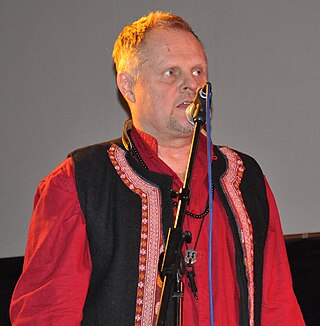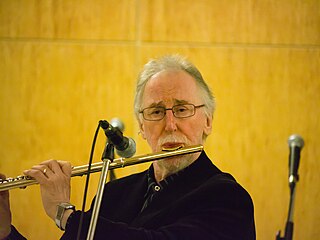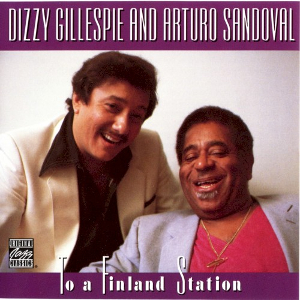
John Birks "Dizzy" Gillespie was an American jazz trumpeter, bandleader, composer, educator and singer. He was a trumpet virtuoso and improviser, building on the virtuosic style of Roy Eldridge but adding layers of harmonic and rhythmic complexity previously unheard in jazz. His combination of musicianship, showmanship, and wit made him a leading popularizer of the new music called bebop. His beret and horn-rimmed spectacles, scat singing, bent horn, pouched cheeks, and light-hearted personality have made him an enduring icon.
The music of Finland can be roughly divided into folk music, classical and contemporary art music, and contemporary popular music.

Minton's Playhouse is a jazz club and bar located on the first floor of the Cecil Hotel at 210 West 118th Street in Harlem, Manhattan, New York City. It is a registered trademark of Housing and Services, Inc. a New York City nonprofit provider of supportive housing. The door to the actual club itself is at 206 West 118th Street where there is a small plaque. Minton's was founded by tenor saxophonist Henry Minton in 1938. Minton's is known for its role in the development of modern jazz, also known as bebop, where in its jam sessions in the early 1940s, Thelonious Monk, Bud Powell, Kenny Clarke, Charlie Christian, Charlie Parker and Dizzy Gillespie pioneered the new music. Minton's thrived for three decades until its decline near the end of the 1960s, and its eventual closure in 1974. After being closed for more than 30 years, the newly remodeled club reopened on May 19, 2006, under the name Uptown Lounge at Minton's Playhouse, which operated until 2010, before re-opening as Minton's Playhouse in 2013.

Jyrki Sakari Kukko, is a Finnish musician.
Blues Section are a Finnish rock music group. They started in 1967, formed around the vocalist Jim Pembroke, a British expatriate songwriter now living in Finland. The other members of the band were Eero Koivistoinen (saxophone), Ronnie Österberg (drums), Hasse Walli (guitar), and Måns Groundstroem (bass). Their influences came above all from John Mayall's Bluesbreakers and Jimi Hendrix, who had played a gig in Helsinki in May 1967. One can also hear in Pembroke's British-flavoured song-writing some echoes from The Beatles and The Kinks. Blues Section released a self-titled album late 1967 on Helsinki's Love Records. In 1968 Groundstroem and Pembroke left the band, being replaced by Pekka Sarmanto and Frank Robson, respectively. Also Koivistoinen would leave the band during the same year, and by the end of 1968 Blues Section was over. The Blues Section members would continue in such acclaimed progressive rock bands as Wigwam and Tasavallan Presidentti. Eero Koivistoinen was to become an internationally acclaimed jazz musician, and Hasse Walli would discover world music, playing in such bands as Piirpauke.

Eero Koivistoinen is a Finnish jazz musician and saxophone player, who started his career in the mid-1960s. Koivistoinen has worked as a musician, composer, arranger, conductor, producer and educator. He first heard jazz from the records his sailor brother had brought in from his travels. As a youngster Koivistoinen studied classical violin, saxophone and also composition at the Sibelius Academy, and later jazz at Berklee College of Music in Boston. His first line-up featured the drummer Edward Vesala and bassist Pekka Sarmanto. Koivistoinen was also a member of the seminal Finnish rock band Blues Section in the years 1967 and 1968. In 1968 he released his first solo album, a "literary record" called Valtakunta which featured songs composed to the texts of such poets as Pentti Saarikoski, Jarkko Laine, Tuomas Anhava and Hannu Mäkelä; interpreted by the vocalists Vesa-Matti Loiri, Eero Raittinen and Seija Simola. Eero Koivistoinen's later solo albums such as Wahoo (1972) enjoy a considerable international reputation. His hip hop-influenced 2006 album X-Ray features such people as the vocalists Charles Salter and Bina Nkwazi, DJ LBJ and the rap artist Redrama.

Bola Sete was a Brazilian guitarist known for playing jazz with Vince Guaraldi and Dizzy Gillespie.
Michael Josef Longo was an American jazz pianist, composer, and author.

François Boland was a classically trained Belgian jazz composer and pianist.

Carola Christina Standertskjöld-Liemola, professionally known as Carola, was a Finnish jazz and pop singer. Her style was partially inspired by American singers of the 1950s. Simultaneously, it was in the spirit of the modal jazz scene going down in Europe in the 1960s. Mostly, Carola's jazz repertoire consisted in idiosyncratic versions of American songs in English, while her most famous jazz track "The Flame" was an original composition by Esa Pethman and the lyrics by the singer herself. As the vocalist for Esa Pethman's quartet and Hazy Osterwald's sextet in the early 1960s, Carola made fame in Finland and Sweden, and toured Poland, Czechoslovakia, and Switzerland. Her most significant recording is a session with the Heikki Sarmanto Trio from 1966, which the Finnish Music Information Centre considers among the original blueprints of Finnish jazz. Carola's recordings have been credited for the accosting tone of her contralto voice and her phrasing. The singer also co-produced the groovy approach of her supporting orchestras. In late 1960s and early 1970s, she performed in nine languages and a wide variety of styles, including chanson, schlager, Latin, rock'n'roll, and soul. After her death of Alzheimer's disease in 1997, Carola's music was revived in 2004 with two Best of albums and Carola & Heikki Sarmanto Trio reaching the Finnish charts.

Juhani Aaltonen is a Finnish jazz saxophonist and flautist.

Thad Jones, Mel Lewis and UMO is a big band jazz recording by UMO with guest bandleaders / performers Thad Jones and Mel Lewis. It was recorded in Helsinki in 1977 and was nominated for a 1979 Grammy award in the "Best Jazz Instrumental Performance - Big Band" category.

Heikki Veli Uolevi Sarmanto is a Finnish jazz pianist and composer.

Pekka Juhani Pöyry was a Finnish jazz and rock saxophonist and flutist. He was part of the Pekka Pöyry Quartet and Quintet.

To a Finland Station is an album by trumpeters Dizzy Gillespie and Arturo Sandoval recorded in 1982 and released on the Pablo label. Dizzy visited Finland 1982 to do a concert with the Finnish Studio Orchestra. By coincidence a Cuban group, led by Arturo Sandoval, was also appearing in Helsinki. Predictably, Dizzy got together with Arturo and in one all-night session that extended into the next morning, recorded this album
UMO Jazz Orchestra is a Finnish big band. It was founded in 1975 by jazz musicians Heikki Sarmanto and Esko Linnavalli.
Harry Kaj Olof Backlund was a Finnish jazz trumpeter, composer, arranger, bandleader, theorist, and one of the founders of the Helsinki Pop & Jazz Conservatory and the Jazz Department of Sibelius Academy. He was also one of the founding members of UMO Jazz Orchestra. He was a contemporary music education pioneer in Finland and a long-running senior music theory teacher in Helsinki Metropolia University of Applied Sciences.

Ode to Booker Ervin is an album by American trumpeter Ted Curson which was recorded in Helsinki and first released on the Finnish EMI Columbia label in 1970. The album features Curson with a band composed of local Finnish jazz musicians. The album is dedicated to tenor saxophonist Booker Ervin who died at the end of August 1970, a few days before the recording session.

Jukka Perko is a Finnish saxophonist.














